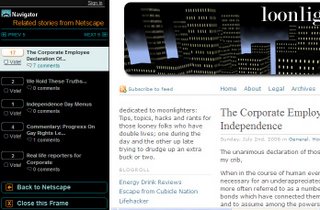 Webmasters use different tactics to link to external sources. Some do everything they can to keep visitors hostages (like Netscape), others want to send them as fast as possible to the right external link (like Google). Here are some of the ways to deal with external links:
Webmasters use different tactics to link to external sources. Some do everything they can to keep visitors hostages (like Netscape), others want to send them as fast as possible to the right external link (like Google). Here are some of the ways to deal with external links:Approach #1: The web is mine.
Open the link in a frame that contains a link to your site (or a back button) and ads. Users will thank you for the half of the screen where they can still browse the external site.
Approach #2: You can always go back.
Open external links in a new window (Firefox may open them in a new tab). When the user closes the new window, he'll see your site and will happily continue to browse it.
Approach #3: What are external links?
Don't put any external links. People should stay on your site. They don't need to know your news source and if they really want to know, there's always Google search.
Approach #4: Internet works without hyperlinks.
Include the external site, but without linking it. Visitors can always copy the link and paste it in their address bar, especially if the URL occupies multiple lines.
Approach #5: Nothing lasts forever.
If I find a news on cnn.com, I'll link just to the homepage, not to the article. If people visit my site tomorrow, when the news won't be on CNN's homepage anymore, they can always use search to find it. There's a word "permalink" invented for blogs... But who cares about blogs?
Approach #6: External links are dangerous.
Let's put a big disclaimer that says: "external links may contain viruses, trojan horses and worms, factual errors and we can't guarantee the validity of the information provided". Let's mark the links with "nofollow" so we don't decrease our PageRank.
Of course, you can also use normal links, without "nofollow", and let your visitors learn more information about the subject of your article.
No comments:
Post a Comment
Note: Only a member of this blog may post a comment.